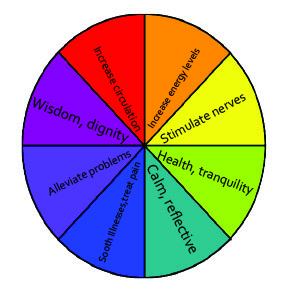Color paints psychology of human brains
May 23, 2019
Ever feel anxious in a yellow room? Does the color blue make you feel calm and relaxed? Artists and interior designers have long believed that color can dramatically affect moods, feelings, and emotions.
Lindsey Brown, art teacher, explains that color is everywhere. Houses, clothes, cars, billboards, tv, etc. The psychology of color says that the colors people interact with influence their moods. For example, The University of Iowa painted its visitor’s locker room light pink in hopes it would put the visiting sports team in a calm, passive mood before the game.
Color can be used to signal action, influence mood, and even influence physiological reactions.
“For those who have experience coloring, it is noticeable when colors are combined, creating a different color. For example, red light mixed with yellow light creates an orange color. Some colors, such as green and magenta, cancel each other out when mixed and result in a white light.” Brown said.
According to funderstanding.com, there are some color effects that have universal meaning. Colors in the red area of the color spectrum are known as warm colors and include red, orange, and yellow. These warm colors evoke emotions ranging from feelings of warmth and comfort to feelings of anger and hostility, while colors on the blue side of the spectrum are known as cool colors and include blue, purple, and green. These colors are often described as calm, but can also call to mind feelings of sadness or indifference.
Color preferences while buying items might say something about the type of image that is being projected. Color preferences, from clothing to a car, can sometimes make a statement about how the person wants other people to perceive them.
Students may prefer to wear darker colors of clothing due to being afraid of being noticed or standing out, by wearing black or dark colors to blend in.
According to funderstanding.com, several ancient cultures, practiced chromotherapy, or the use of colors to heal. Chromotherapy is sometimes referred to as light therapy or colorology and is still used today as an alternative treatment.
In this treatment, Red was used to stimulate the body and mind and to increase circulation. Yellow was thought to stimulate the nerves and purify the body. Orange was used to heal the lungs and to increase energy levels. Blue was believed to soothe illnesses and treat pain. Indigo shades were thought to alleviate skin problems.
Interest in the subject of color psychology is growing, but there remain a number of unanswered questions. How do color associations develop? How powerful is the influence of these associations on real-world behavior? Can color be used to increase worker productivity or workplace safety? Do certain personality types prefer certain colors? As researchers continue to explore such questions, scientists may soon learn more about the impact that color has on human psychology.
Zena O’Connor, a faculty member in the Department of Architecture and Design, suggests that people should be wary of many of the claims they see about the psychology of color.
“Many of these claims lack substantiation in terms of empirical support, exhibit fundamental flaws, such as causal oversimplification and subjective validation, and may include factoids presented as facts,” O’Connor explains. “In addition, such claims often refer to outdated research without referring to current research findings.”
While color can have an influence on how people feel and act, these effects are subject to personal, cultural, and situational factors. More scientific research is needed to gain a better understanding of color psychology.




